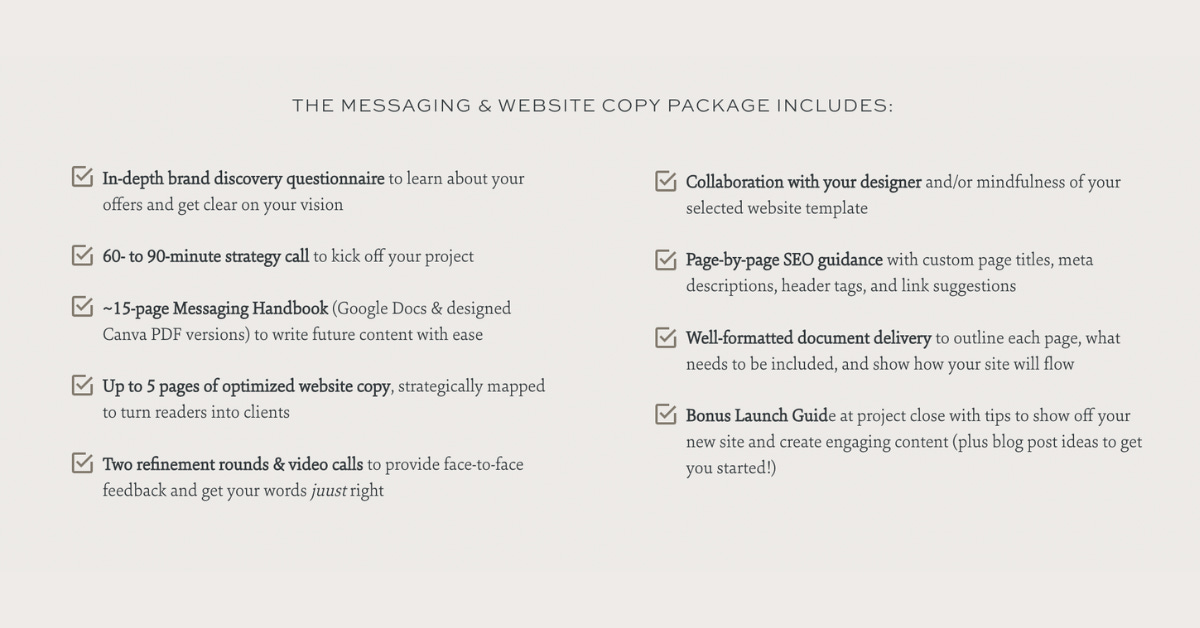
This is part four of my Write Your Site Series: A 6-part guide to writing your core website pages (Home, About, Services, and Contact), followed by a step-by-step checklist to launching and marketing your new site. Today’s post is about how to better organize your services page so you become a no-brainer to book.
You probably offer more than one service — or at least more than one package. Which means you need to structure your offerings in a way that’s not confusing or overwhelming to your website visitors.
As Donald Miller says, “If you confuse, you’ll lose.”
And nobody likes to lose. Especially when it comes to bookings in your business.
Luckily, there are a few tricks you can use to make your services page more straightforward.
Here are three tricks to writing a services page that points your people in the right direction so they can inquire with ease.
1. Map Out Your Process
Every service package includes many moving parts to get your clients from A to B…
But I’d be willing to bet that most of the steps you take are happening behind the scenes. Meaning that you don’t need to advertise every single step of your process on your website.
If you did, it’d make your reader feel more, That sounds like a lot of work, than, Woah, that sounds efficient and effective. Let’s do it!
For example, my FULL process looks something like this:
- Reader inquires on my website
- I review the inquiry
- I respond to their inquiry to answer any initial Q’s and book a 20-minute connect call
- 20-minute connect call happens
- If we’re a match made in heaven, I send a custom proposal, contract, & invoice
- Reader signs contract & pays deposit invoice
- Reader officially becomes a client – yay!
- Client receives link to complete their Onboarding Questionnaire
- I schedule project kickoff call with Client
- On our project start date, Client and I meet to go through all things project strategy
- I dive into research
- Then I dive into writing
- Client receives brand messaging, website copy, &/or SEO audit for feedback
- Client sends feedback
- I revise the deliverable based on feedback
- Once finalized, we meet for an offboarding call where I hand off the final document(s), share my exclusive client launch guide, and get in touch with their designer (if they have one) to get a final copy edit and proofread on my calendar before Client launches!
PHEW! That’s a lot of steps. And that’s even condensed a bit so you don’t have to read about all the little things my trusty CRM takes off my plate, too.
If I put alll of that on my website, people would get bored by the second bullet point… and probably move on to another copywriter’s website to see if their process feels more relaxing.
The moral of the story is your readers don’t need every detail. They need just enough to become interested in learning more on a connect call with you (or whatever your next step is).
You can save all the nitty gritty details for your proposal to make sure they’re crystal clear on how your process works and what your service includes.
So, to avoid process overwhelm, think about your process in 3-5 phases.
On my Services page, I have 4 phases listed, each with a bit of context to add both clarity and personality:
- Meet & Greet (the inquiry/connect call phase mentioned above)
- Research & Write (where the magic happens)
- Revise & Wrap Up (where final edits are made to your heart’s content)
- Launch & Celebrate (where you *finally* put that business of yours out into the world and pop that cork to celebrate a job well done)
YOUR ACTION STEP:
To whittle down your process to 3-5 digestible phases, you’ll first need to write out every last grueling step.
Now, cross off those details that you’ll go over again in your connect call, onboarding process, and offboarding process.
Bunch the remaining tasks into categories or phases that accurately reflect the experience you provide.
Finally, put a name to each phase and write a couple sentences about what they’ll experience during that phase.
Bonus points if you give them more personality than Inquiry, [Thing You Do], Refinements, and Offboarding, and tie them into your brand theme (if you have one).
2. Categorize Your Offerings
If you’re a service provider, odds are you offer different levels of your service, from bare bones to the whole shebang.
This is a great way to cater to people at different stages of their business or life or journey. But how do you steer each of those people toward the right service for them?
By categorizing your offerings.
There are several ways to do this.
A bookkeeper, for example, might offer full-service bookkeeping (AKA a done-for-you service); a 3-month consulting packages to set financial goals and create systems for tracking & reaching those goals (AKA a done-with-you service); and a course on how to track your finances as a solopreneur (AKA a do-it-yourself service).
In this instance, done-for-you, done-with-you, and do-it-yourself are the 3 categories of services they offer. This hypothetical person could put these categories side-by-side, write who each is best for, and include a button for each that leads to a sales page detailing that particular service.
If that system doesn’t work for your business, here are some other examples to get your ideas flowin’:
- A family photographer specializing in outdoor photo shoots offers 3 levels of their package. Their categories could have on-theme names and deets on what comes with each. Off the top of my head, here’s what this could look like:
- The Sprout Package: 1 hour, 1 location, 0 outfit changes, 20 photos
- The Sapling Package: 2 hours, 1 location, 1 outfit change, 40 photos
- The Grove Package: 3 hours, 2 locations, 2 outfit changes, 60 photos
- An interior designer might offer their services for Renovations, New Builds, and E-Design.
- A coffee shop might have a cafe you can visit and a cart you can rent for parties.
- A website designer offers website templates, 1:1 design services, and courses. Their categories could be Shop, Hire, and Learn.
In each of these instances, the website visitors will be looking for something different. So make it clear to them that you have what they need!
YOUR ACTION STEP:
Think about who each of your services is for. Write out the name of your service and pair it with a detailed description about who each service is best for.
This will help you visualize where each of your potential clients are in their journey so you can break up your services accordingly.
3. Know the Difference Between Benefits and Features
One of the biggest mistakes I see on service pages is using only features to sell your service packages.
And while the features of a service are important, the benefits are usually more important.
So, what’s the difference?
Features tell your reader what’s included in a service, like the number of revision rounds they’ll get, the number of calls included, or the actual deliverables they’ll receive.
Benefits tell your reader how your service will change their life (AKA why they should care).
My services page, for example, marries the two by introducing each service with a short paragraph on what it does to make their life easier before diving into the features of the service via a bulleted list.
My Messaging & Website Copy package introduces the service and then shows how some features benefit the reader.

Let’s look closer at the line that reads, “Up to 5 pages of optimized website copy, strategically mapped to turn readers into clients.”
This doesn’t just say you’ll get 5 pages of website copy. It ALSO says that you’ll get a document strategically mapped to guide your readers all the way to conversion.
Now you know this isn’t just words on a page, but it’s backed by conversion strategy too.
YOUR ACTION STEP:
Write a list of what each of your services includes (the features). Then think about how each feature makes your clients’ lives easier (the benefits).
Finally, summarize those benefits into a succinct 1-3 sentence description. That’s the copy you’ll use to introduce each service before diving into a bulleted list of features.
There you have it! Three secrets to organizing your offers and creating a services page that doesn’t overwhelm your readers.
But before I wrap this up, here’s your reminder that your website is a living, breathing part of your business. It’s okay if it’s a work in progress. And it’s okay if you make continuous improvements as you learn more about your audience, obtain feedback, and perfect your process.
Don’t let the false notion that you need a *perfect* website to launch your business hold you back from starting. You & your wallet will thank you for it.
If you’re at a point where you’re ready to upgrade your site design to better showcase your services, here’s 15% off my favorite Showit website templates as a thanks for reading all the way through. Use code ‘upstairsstudio’ at checkout to get your discount!
Pair your new site template with one of my website copywriting services & launch a site that makes you, your audience, AND Google very, very happy.
+ view the comments



